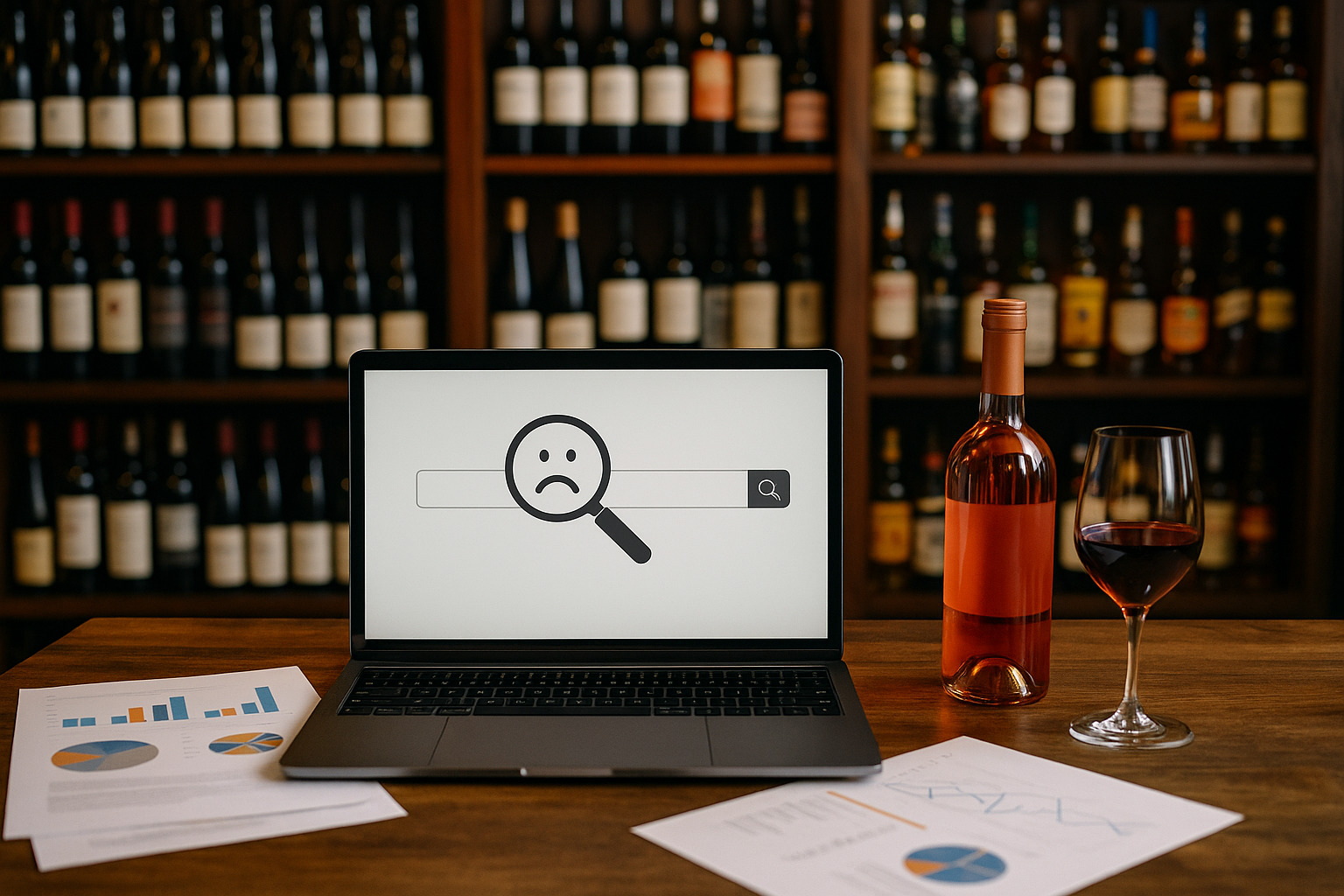Medium-sized online-only wine and spirits merchants are facing a perfect storm in 2025. Organic search visibility is shrinking, ad costs are soaring, and large platforms dominate rankings. Add to this the difficulty of standing out in a crowded marketplace, the rise of conversational agents, and the challenge of engaging younger, hyper-connected consumers — and the need for new strategies becomes clear.
The New Reality: Why Traditional SEO Alone No Longer Delivers
For years, merchants relied on search engines to drive qualified traffic. Today, algorithm volatility, AI-powered search replacing results with direct answers, and competition from giant retailers have eroded that channel. For online-only merchants without physical stores, the absence of Google My Business presence further limits visibility. The result? A reliance on expensive paid ads that rarely generate loyal, repeat customers.
Pain Point: Competing Against Giants
Vivino, Amazon, and supermarket-backed platforms are outspending and outranking small and medium players. Price becomes the only differentiator, and margins erode. Merchants need to shift from “trying to beat Google” to building direct, owned channels of traffic.
Strategic Levers to Regain Qualified Traffic
1. Build Trust Through Conversational Commerce
Today’s consumers expect immediate, personalized, and trustworthy guidance. Medium-sized merchants often lack the staff or budget to deliver this 24/7. Conversational agents, when done well, can act as a digital sommelier – guiding, teaching, and recommending in real time. Unlike generic chatbots, platforms like sommelier.bot combine wine expertise with AI scale, providing qualified visitors with the right recommendation in less than 30 seconds.
2. Differentiate With Educational Content
Instead of another “Top 10 Prosecco” list, merchants should double down on content that solves real discovery problems. Interactive wine maps, food-pairing guides, and short, mobile-friendly learning experiences meet younger consumers where they are. See our analysis on how to attract younger Wine & Spirits consumers with hyper-personalized wine experiences.
3. Leverage Federated Platforms Without Losing Identity
A key fear of medium-sized merchants is losing customer ownership to platforms. With sommelier.bot’s federated model, you keep your own inventory, your brand identity, and your customer data – while benefiting from a free listing on the universal AI wine platform. Qualified visitors are redirected to your product pages, combining reach with ownership.
4. Activate Community Engagement Beyond SEO
AI discovery tools and social media have shifted consumer journeys away from keyword searches. Merchants need to cultivate micro-communities around taste, occasions, and lifestyle. Host online tastings, gamify discovery, and encourage user-generated content. Tools like sommelier.bot provide built-in gamification, wine quizzes, and virtual cellars that help turn passive buyers into loyal advocates.
Tactical Plays for Wine & Spirits Online Merchants
Implement a Conversational Widget in One Week
Instead of months-long IT projects, merchants can integrate a sommelier.bot widget with a single line of code. The widget adapts to your inventory, offers hyper-personalized recommendations, and converts up to 23% of engaged visitors — a figure already proven across 40+ merchants worldwide.
Offer Unique Experiences, Not Just Products
Younger consumers are less loyal to brands, but they are loyal to experiences. Offer fast pairing suggestions for Netflix nights, curated discovery packs, or cellar-building journeys. Conversational commerce allows you to deliver these experiences at scale, with no added staff cost.
Turn Education Into Retention
Wine complexity is a barrier for many new customers. Instead of long category filters, use conversational flows that explain grape varietals, regions, and food pairings in plain language. Sommelier.bot’s AI is trained on 13 million wines and thousands of grapes, making it easy to scale knowledge that would otherwise require expert staff.
Safeguard Against Platform Dependency
SEO, Google Ads, Instagram reach – all can vanish overnight with an algorithm tweak. Owning your customer journey through AI-driven engagement, newsletters, and direct recommendations ensures that your sales funnel doesn’t collapse with every change in Silicon Valley.
Why Medium-Sized Online Wine & Spirits Merchants Have an Edge
Ironically, being mid-sized is an advantage. You are agile enough to adopt new tech without bureaucratic delay, but established enough to command customer trust if you deliver a premium experience. Large players can’t personalize at scale, and small shops lack resources. The middle tier can win – if it invests in hyper-personalization, education, and community engagement.
From Surviving to Leading in the AI-First Era
The wine and spirits trade is moving into a world where discovery happens in conversations, not category pages. SEO will not disappear, but its role will shrink. Medium-sized online-only merchants who cling to the old playbook risk becoming invisible. Those who embrace conversational commerce, interactive content, and federated AI platforms will not just survive — they will lead.
If you’re ready to explore how AI can drive qualified traffic, improve conversion, and deliver a unique customer experience, visit the leading AI sommelier and request a demo today. Your competitors are already experimenting. The question is: will you lead or lag?
And remember, the sommelier.bot was created by the industry, for the industry, with any merchant partner being a future shareholder of the platform, unlike Vivino…
Test the leading AI sommelier
Open the sommelier.bot app and start a full conversation about wine & spirits. If you like it, get it for your own inventory, or upload it for FREE on the public sommelier.bot AI app.
